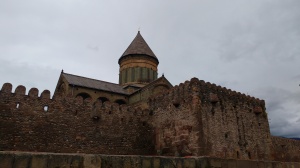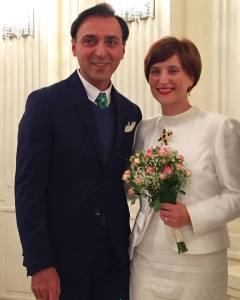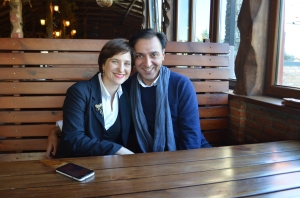When jogging last Friday morning I was surprised at the silence of the streets. Cars remained tightly pressed to one another on the sidewalks, and only one of them tried to move cautiously out of its parking place to go elsewhere. No children rushed to school, and yard-keepers, in their orange coats and hats, were sweeping the fallen leaves from under the trees. Since the dominant religion in Georgia is Orthodox Christianity, I thought that it was a free day, and the holiday celebrated was the same Intercession of Virgin Mary which is observed in Ukraine as a national holiday. However, later that day I came to know that on October 14 the Georgians celebrate a different spiritual holiday – Mtskhetoba-Svetitskhovloba.
Mtskheta, located some 20 km to the north of Tbilisi, had been the capital of Georgia (Iberia) until the 5th century A.D. The Svetitskhoveli Cathedral is a temple in this city. So, the feast of Mtskhetoba- Svetitskhovloba honors both the city and the temple.
Svetitskhovloba honors both the city and the temple.
 The ending “-oba” rang a bell with me. When attached to the name of the modern capital Tbilisi (“Tbilisoba”) it stands for an annual October festival that celebrates the cultural life and diversity of Georgia featuring concerts of folklore music, dancing and numerous cultural events. Usually Tbilisoba is celebrated in Tbilisi, but this year it was observed by the Georgian diaspora at Andriyivskyi Uzviz in Kyiv too – with the exquisite Georgian cuisine and traditional
The ending “-oba” rang a bell with me. When attached to the name of the modern capital Tbilisi (“Tbilisoba”) it stands for an annual October festival that celebrates the cultural life and diversity of Georgia featuring concerts of folklore music, dancing and numerous cultural events. Usually Tbilisoba is celebrated in Tbilisi, but this year it was observed by the Georgian diaspora at Andriyivskyi Uzviz in Kyiv too – with the exquisite Georgian cuisine and traditional  choral singing. Especially thrilling was the moment when a folklore group, in their black chokha outfit and daggers at their belts were performing (as a sign of respect for
choral singing. Especially thrilling was the moment when a folklore group, in their black chokha outfit and daggers at their belts were performing (as a sign of respect for  the Ukrainians) a Ukrainian song “The Wide Dnipro Roars and Moans.”
the Ukrainians) a Ukrainian song “The Wide Dnipro Roars and Moans.”
However, Tbilisoba and Mtskhetoba-Svetitskhovloba are radically different. While the former is a secular holiday, the latter is strictly religious. The legend has it  that in the 1st century AD, two Jews who had witnessed the crucifixion of Jesus and became Christian believers, brought to Georgia the tunic in which Jesus had been executed. Georgians will also tell you that on the burial place of the tunic rose up a sacred cedar, which later began to ooze forth
that in the 1st century AD, two Jews who had witnessed the crucifixion of Jesus and became Christian believers, brought to Georgia the tunic in which Jesus had been executed. Georgians will also tell you that on the burial place of the tunic rose up a sacred cedar, which later began to ooze forth  myrrh and gave people healing from ailments. From all part of the Caucasus pilgrims began to come to the place. They named the cedar a “life-giving pillar”. In the 4th century, the king of Georgia – Mirian – decided to build a church in its
myrrh and gave people healing from ailments. From all part of the Caucasus pilgrims began to come to the place. They named the cedar a “life-giving pillar”. In the 4th century, the king of Georgia – Mirian – decided to build a church in its  place. The cedar was cut down, but the trunk could not be moved. St. Nino, a missionary from Rome, was
place. The cedar was cut down, but the trunk could not be moved. St. Nino, a missionary from Rome, was  the only one who could beg the blessing of the Lord to move it. An invisible force lifted the trunk into the air and dropped into place, where soon a wooden church arose. In the 11th century the decayed church was replaced by the Svetitshoveli Cathedral. St. Nino’s icon is now in the cathedral, and the grapevine cross, with which she came to Georgia (then Iberia) to preach the Gospel, is a symbol of Georgian Christianity. A copy of that cross (also called St Nino’s cross) with a recognizable slight drooping of horizontal arms is set up in the yard of the Svetitskhoveli Cathedral, and tourists love to be photographed next to it.
the only one who could beg the blessing of the Lord to move it. An invisible force lifted the trunk into the air and dropped into place, where soon a wooden church arose. In the 11th century the decayed church was replaced by the Svetitshoveli Cathedral. St. Nino’s icon is now in the cathedral, and the grapevine cross, with which she came to Georgia (then Iberia) to preach the Gospel, is a symbol of Georgian Christianity. A copy of that cross (also called St Nino’s cross) with a recognizable slight drooping of horizontal arms is set up in the yard of the Svetitskhoveli Cathedral, and tourists love to be photographed next to it.
It’s also thrilling to walk through the narrow medieval streets of old Mtskheta – narrow and cobbled.
The Georgians have a very strong retrospective thinking. Even though the capital of the country was moved from Mtskheta to Tbilisi seventeen centuries ago, they keep calling Tbilisi “the new capital”, while Mtskheta remains for them “the old capital.” Lots of high schools in Georgia begin their academic year (it starts on September 15) by trips to Mtskheta.
 Ludmyla and I arrived at Mtskheta as “parents.” Our daughter Yasya and Irakli had their wedding at the Svetitskhoveli Cathedral. That was a church wedding (a civil registration of their marriage took place earlier). First we had came to the Cathedral a day before, because Yasya’s maid of honor Sanya (her long-standing
Ludmyla and I arrived at Mtskheta as “parents.” Our daughter Yasya and Irakli had their wedding at the Svetitskhoveli Cathedral. That was a church wedding (a civil registration of their marriage took place earlier). First we had came to the Cathedral a day before, because Yasya’s maid of honor Sanya (her long-standing 
 friend from Serbia) had to be baptized before she could attend Yasya during the wedding and give her emotional and spiritual support. Being held in a temple which had witnessed centuries of Christian history, Sanya’s baptism was an uplifting moment. Now Sanya was really a person born anew: you could see it by the shine of her eyes, by her smile, by her posture.
friend from Serbia) had to be baptized before she could attend Yasya during the wedding and give her emotional and spiritual support. Being held in a temple which had witnessed centuries of Christian history, Sanya’s baptism was an uplifting moment. Now Sanya was really a person born anew: you could see it by the shine of her eyes, by her smile, by her posture.
 Needless to say that for my wife and me, our daughter’s marriage held the next day was the pinnacle of happiness. Any parents will understand us. This country and its people have become as close and dear to us, as they are to Yasya. “Please, know that Yasya is absolutely safe with us. Don’t worry about her,” assured us our numerous in-laws. We know. We are sure.
Needless to say that for my wife and me, our daughter’s marriage held the next day was the pinnacle of happiness. Any parents will understand us. This country and its people have become as close and dear to us, as they are to Yasya. “Please, know that Yasya is absolutely safe with us. Don’t worry about her,” assured us our numerous in-laws. We know. We are sure. 
After the wedding ceremony there was a lot of picture-taking: every family of relatives wanted to be photographed next to the newly-weds. Then a short trip to the Dzhvari monastery followed. It’s another inspiring place: being the setting of Mikhail Lermontov’s romantic poem “Mtsyri” (“The Novice”) it also heartens all lovers of literature. Besides, the monastery rises high over the surrounding ranges of mountains and, as Yasya told us, makes the most beautiful view in Georgia.
The reception in the evening was  unforgettable. There was much of Georgian folklore on the podium. My impression was that at any moment any person sitting at table could jump up from their seat, rush to the front and present –spontaneously and brilliantly – a Caucasian song or dance. How talented they are, these people! While songs were sung and dances performed, Irakli’s relatives were never tired explaining to us which part of Georgia this or that piece of
unforgettable. There was much of Georgian folklore on the podium. My impression was that at any moment any person sitting at table could jump up from their seat, rush to the front and present –spontaneously and brilliantly – a Caucasian song or dance. How talented they are, these people! While songs were sung and dances performed, Irakli’s relatives were never tired explaining to us which part of Georgia this or that piece of  art came from. A real surprise was two Ukrainian songs: The Red Rue (it has been invariably popular in Ukraine since 1968 when it was first performed) and the energetic “You Have Cheated Me, My Dear…”
art came from. A real surprise was two Ukrainian songs: The Red Rue (it has been invariably popular in Ukraine since 1968 when it was first performed) and the energetic “You Have Cheated Me, My Dear…”
Usually translated as a “toastmaster”, the Georgian word “tamada” is more than that. The tamada is a ruler of a supra (feast), the pivot round whom everything rotates. First, Irakli’s cousin Koba rose to his feet and profusely thanked all those present for having chosen him to be a “tamada.” By  each toast he came to a person he chose, that person had to stand up holding a glass filled to the brim, and, with his silent consent, support what the tamada said. Each toast that Koba pronounced was a lengthy speech listened to by all those present. Knowing only a few Georgian phrases of greeting and farewell, I consulted my in-law who sat on my right, what the toasts were about (“And this time, what shall I have to drink to, Revaz?”). The themes varied from the health and well-being of the newly-wed couple through the health and well-being of all those who were in the hall and also all those who couldn’t attend the reception for some reason, to more global themes of the past, present and future of both Georgia and Ukraine.
each toast he came to a person he chose, that person had to stand up holding a glass filled to the brim, and, with his silent consent, support what the tamada said. Each toast that Koba pronounced was a lengthy speech listened to by all those present. Knowing only a few Georgian phrases of greeting and farewell, I consulted my in-law who sat on my right, what the toasts were about (“And this time, what shall I have to drink to, Revaz?”). The themes varied from the health and well-being of the newly-wed couple through the health and well-being of all those who were in the hall and also all those who couldn’t attend the reception for some reason, to more global themes of the past, present and future of both Georgia and Ukraine.
A moment of special fun at the reception was carving the wedding cake (see the photos). Of course, everybody understands that married life is not sweet dessert all through, but a sweet push into it is symbolic. Symbols do matter.
 As it is usual at weddings, relatives clinked glasses with the married couple, told them their wishes and, being more “experienced” 🙂 gave them “instructions” on how to live on. Now we have many relatives here in Georgia. We are rich people now.
As it is usual at weddings, relatives clinked glasses with the married couple, told them their wishes and, being more “experienced” 🙂 gave them “instructions” on how to live on. Now we have many relatives here in Georgia. We are rich people now.


